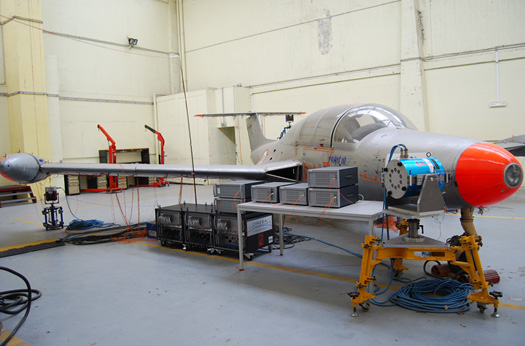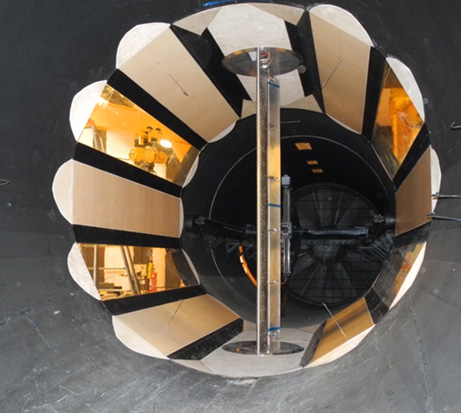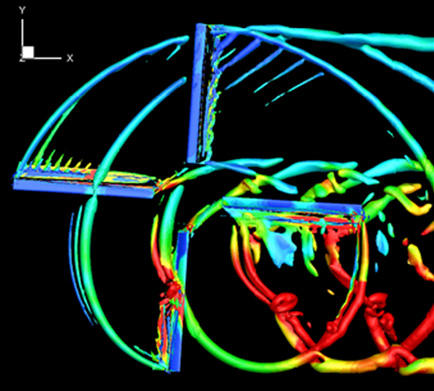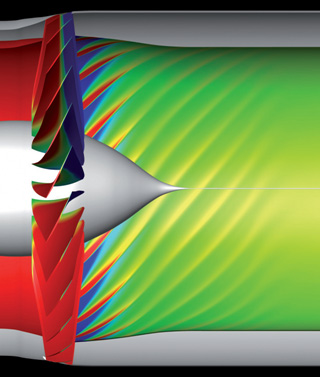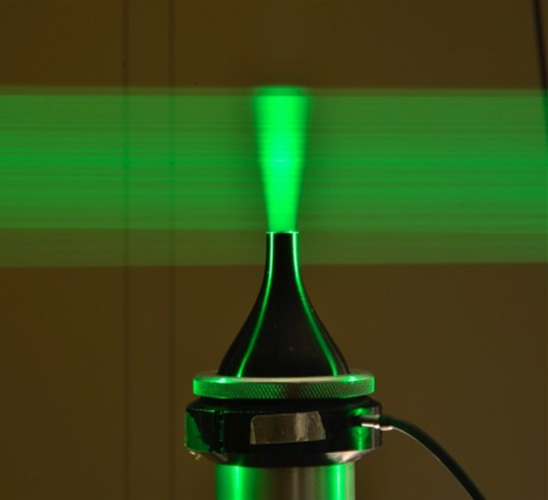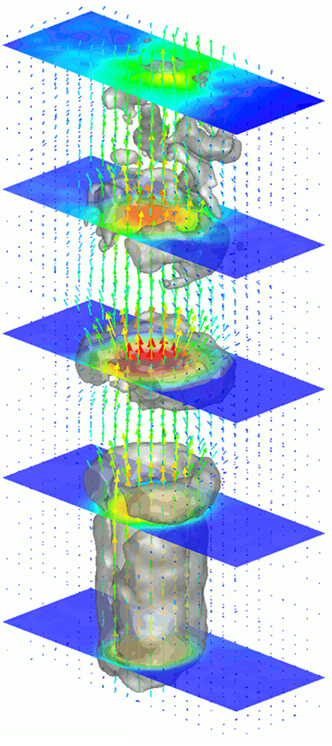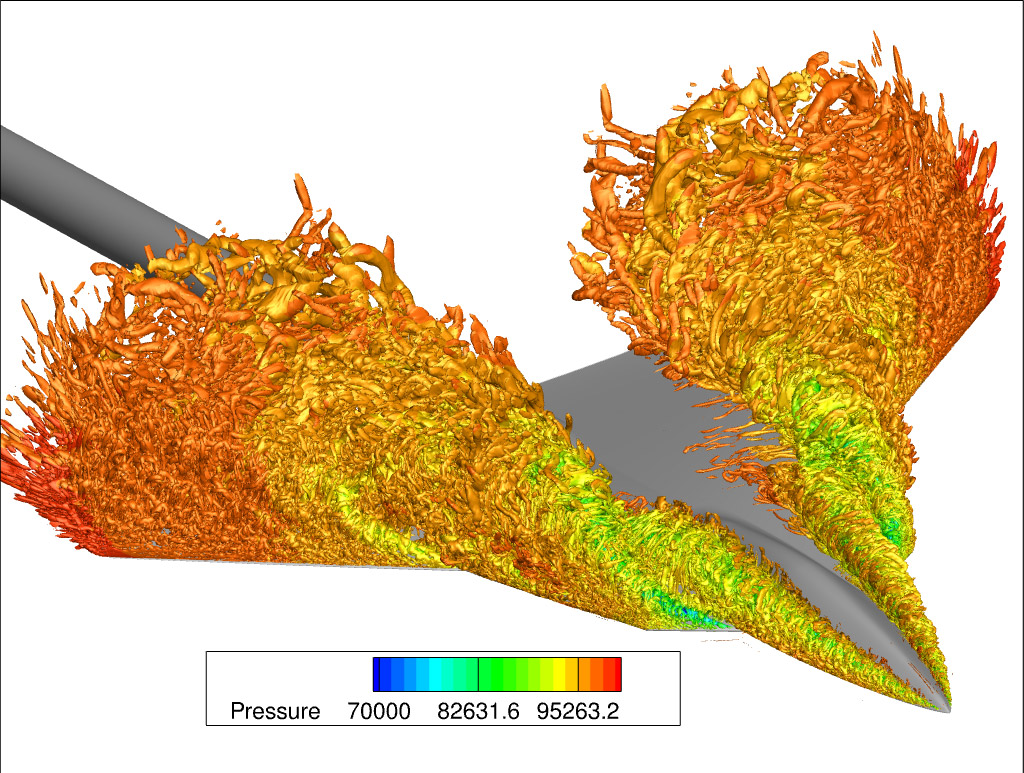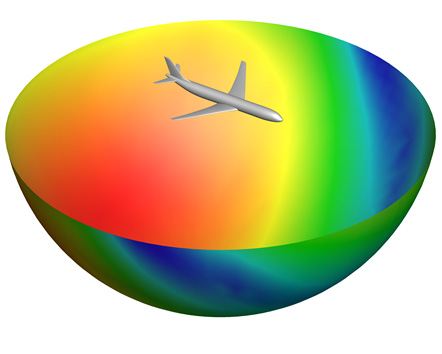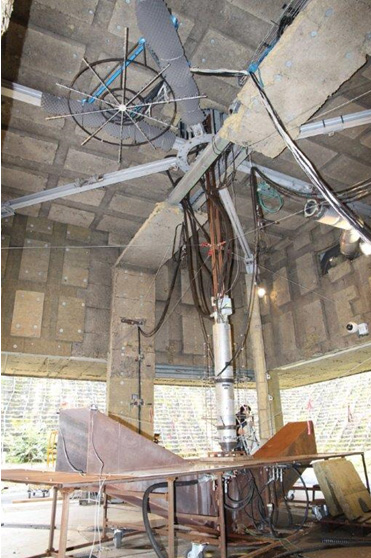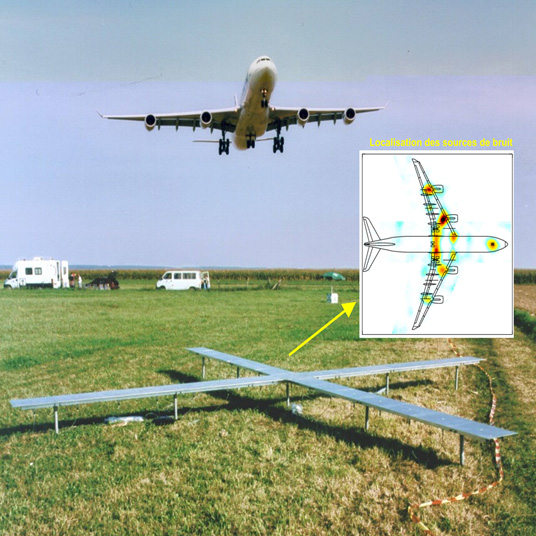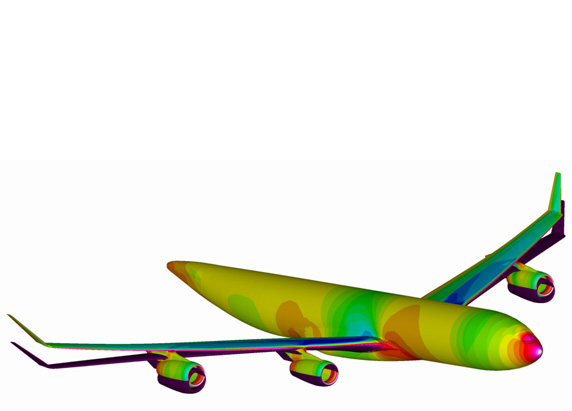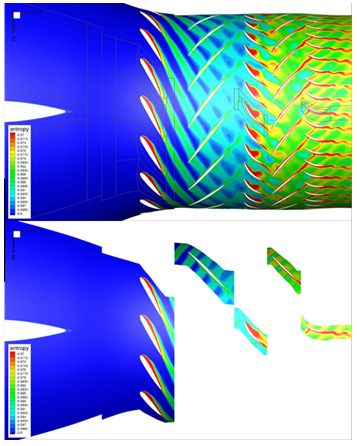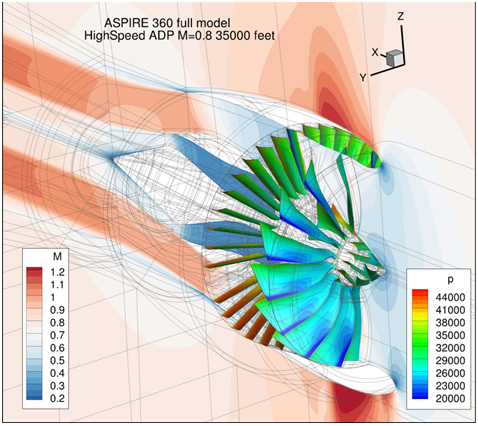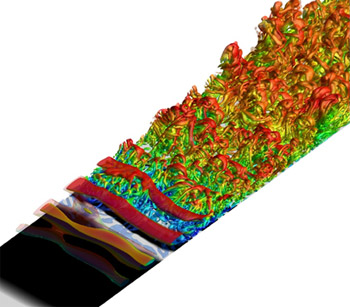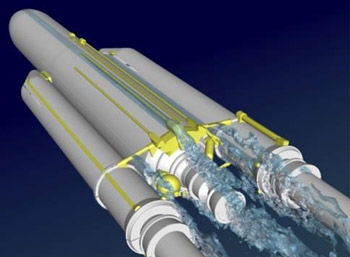- ONERA
- Scientific Departments
- DAAA - Aerodynamics Aeroelasticity Acoustics
- Research units
DAAA - Research units
ACI | AMES | ADSE | CLEF | DEFI | ELV / LMFL | H2T | MAPE | MASH | MAXE | MSAE | MSAT | NFLU | SN2A
Civil aircraft (ACI)
ACI contribute to the development and validation of numerical tools dedicated to the assessment and analysis of phenomena specific to the external aerodynamics of aircraft configurations (commercial, business, light aviation aircraft, etc.). The unit implement these tools and exploit experimental databases to improve physical understanding of these phenomena across the entire flight domain (cruise, high-speed, low-speed, stall, manoeuvers, etc.). ACI help improving the aerodynamic performance of aircraft through the design of optimal aerodynamic shapes and the introduction of specific technologies, such as flow control or laminarity. It also contributes with proposals and assessments regarding new concepts of future aircrafts.
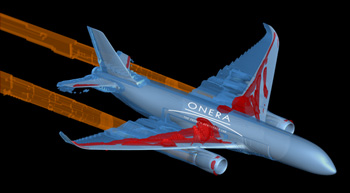
Evaluation of aircraft contrail via far-field
approach
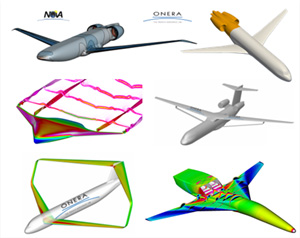
Study of new configurations
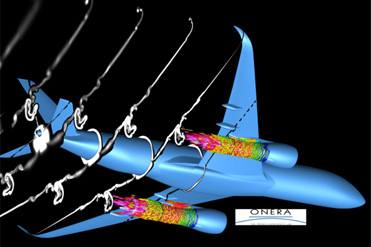
Study of the wake of a transport aircraft
via advanced numerical simulation
Aerodynamics, experimental methods and wind tunnel (AMES)
AMES is the team in charge of the wind tunnels and high pressure compressed air station at ONERA Meudon research center. These wind tunnels cover a wide spectrum of aerodynamic conditions from low subsonic to cold hypersonic speeds. AMES is devoted to the design and realization of experiments in these facilities, while ensuring their full operation (maintenance).

Load tests on a flexible wing in the S3Ch transonic wind tunnel
Aeroelasticity and dynamics of experimental structures (ADSE)
The missions of ADSE concern topics associated with Vibratory Dynamics and Aeroelasticity. The activities carried out are mainly experimental and address the following issues:
- Characterizing and identifying the dynamic behavior of aeronautical structures
- Designing and conducting tests on aeroelastic mockups in wind tunnels for better understanding of the physical phenomena
- Contributing to the validation and calibration of predictive numerical simulation
Design and production of software for fluid flows (CLEF)
CLEF is tasked for producing large software platforms for simulating fluid mechanics. Those platforms are capable of meeting, for various purposes in the aerospace and defence sectors, the research and application needs of ONERA, of partner research laboratories and of industry.
Demonstrations, efficiency, reliability and interoperability of software (DEFI)
DEFI carries out research work on numerical methods and technologies suited to high-performance numerical simulations. It also conducts demonstration calculations at the frontiers of the computational resources. Furthermore, DEFI develops software for pre-processing, post-processing, meshing methods, digital geometry and visualization for numerical simulations.
Experimentation and flight limit (ELV) and the Lille - Kampé de Fériet fluids mechanics laboratory (LMFL)
ELV develops mainly experimental research activities structured around:
- The physics of flows (characterization and control, metrological development, etc.)
- The aerodynamics of vehicles
- The study of the vehicle dynamic behavior at the limits of the flight envelope
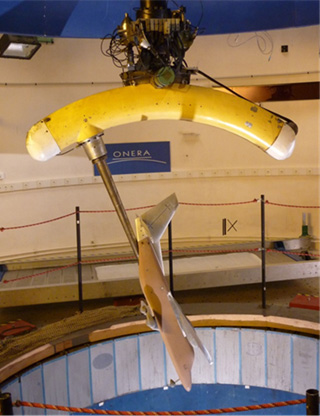
Experimental characterization in SV4 vertical
wind tunnel of a transport aircraft at the
limits of its flight envelope
The Lille Fluid Mechanics Laboratory - Kampé de Fériet (CNRS UMR 9014) was created on January 1, 2018 merging two research entities: the "Rotating and Turbulent Flows" team of the former Lille Mechanics Laboratory and the "Experimentation and Flight Limit" research unit of ONERA Lille.
The unit is composed of 38 permanent staff (researchers, research-professors, engineers and technicians) and around 25 PhD students and research fellows. The laboratory is located in three sites: Lille (ENSAM and ONERA) and the campus of Villeneuve d'Ascq (Centrale Lille, CNRS, Lille University).
Helicopters, propellers, turbomachines (H2T)
H2T conducts research work and studies on the applied aerodynamics of wings and rotary machines, in particular for helicopter applications (classic, tilt-rotor, combined configurations), propellers (for the entire spectrum of aeronautical applications) and turbo machineries (fans, compressors, turbines). The field of activity covers the development and implementation of tools and methodologies for different fidelity levels of simulation. It also covers the detailed validation of predictive capabilities through comparisons against experimental databases.
Metrology, assimilation, physics of flows (MAPE)
The MAPE unit addresses three research topics: the implementation of conventional measurement devices in models and wind tunnels (pressure, temperature, forces); the development and implementation of optical measurement techniques (Pressure-Sensitive Paints, 2D and 3D PIV, LDV, infrared thermography); and the development of data assimilation methods for merging measurements and numerical simulations data for optimized characterizations. The tools issued from these research activities are also used in the unit for analyzing and inspecting fundamental physical phenomena in flows (jet dynamics, flow separation, fluid-structure instabilities, for example).
Development of PIV 3D: application on a jetMissiles, fighter aircraft, stability, hypersonic (MASH)
MASH deals with the aerodynamics of all defence applications, except the aerodynamics of tactical transport aircrafts and helicopters. This covers the following applications: missiles and projectiles, supersonic air intakes of missiles and aircrafts, rear bodies of fighter aircraft, carrying payload integration and jettisoning, launch vehicles (nozzles and rear bodies), hypersonic aircraft and UCAVs. The scientific topics developed in the unit draw on advanced turbulent unsteady simulations (concerning the physical analysis of mainly supersonic and hypersonic flows in cold gas), the transition and stability of flows at high speed, and flow control and meta-modeling.
Acoustic methods for experimentation and the environment (MAXE)
MAXE covers all environmental aspects linked to noise nuisance, from the implementation of metrological techniques for measuring noise up to the inconvenience experienced by local residents, by way of sources identification, detection, and the problems of propagation and environment.
Modeling and numerical simulation for aeroelasticity (MSAE)
MSAE develops methods and digital tools for behavior forecasting prediction and aeroelastic design of structures in their environment. Its range covers the study of static and dynamic aeroelastic phenomena for fixed and rotary wings, as well as aeroelastic and aerostructure optimization.
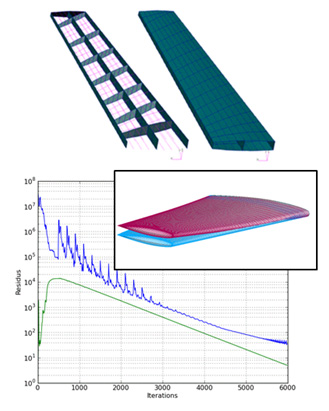
Optimization of the form parameters
of an M6 wing aerostructure model
(static coupling)
Advanced turbulence modeling and simulation (MSAT)
MSAT contributes to the definition of advanced modeling for numerical simulation of unsteady turbulent flows (RANS, ZDES, WMLES, DNS) and ensures their compatibility with aeronautical and space applications through integration of geometric complexity (IBC). Its purpose is also to guarantee a high validation level for these modelings using post-processing tools developed for the flow physics in-depth analysis (near-wall turbulence and separated flows with high Reynolds numbers ranging from the subsonic to the cold hypersonic).

Large-scale simulation (WRLES) of a turbulent boundary layer in space development with a large
Reynolds number (Req=104)
Digital methods for fluid mechanics (NFLU)
NFLU conducts activities related to the study and development of numerical methods for the solution of fluid mechanics systems of equations, using various types of space-time discretization methods associated to structured, unstructured and hybrid mesh strategies. In particular the algorithmic developments for the Navier-Stokes model are performed in the aerodynamic codes elsA and Aghora developed at ONERA, as well as in the new Airbus-ONERA-DLR code CODA. The topics concern more precisely:
- Error estimation and hp adaptation for certification of calculations
- Multi-physical and multi-model coupling methods
- Digital methods for stochastic mechanics and robust simulation chain
- Large-scale linear algebra and HPC optimisation
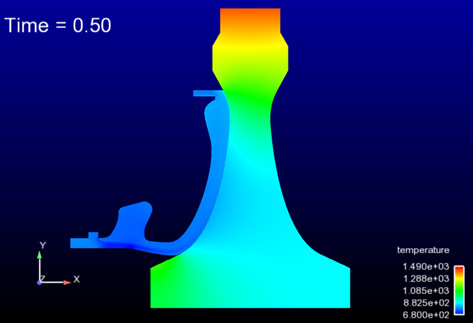
Aerothermal coupling
Optimal coupling founded on a Godunov-Ryabenkii
stability study
Aeroacoustic numerical simulation (SN2A)
The research unit SN2A develops and executes numerical methods and tools that aim at solving aeroacoustic problems. More specifically, the topics addressed are:
- Rotating lifting surfaces (Fans, propellers, helicopter and VTOL rotors)
- Turbulent jets and combustion noise
- Airframe noise (airfoils, slats and flaps, cavities, landing gears)
- Installation effects of noise sources at the aircraft scale
The studies carried out aim at predicting the noise radiated by these different sources and at better understanding their underlying physics in order to design future noise mitigation concepts.

